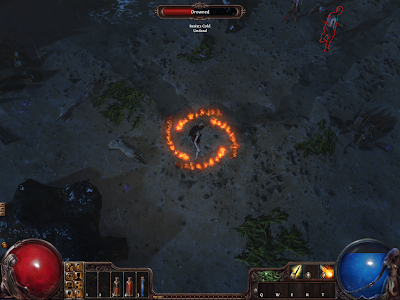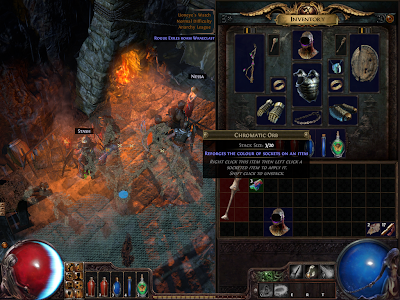Wondering what I've been doing lately? Well, I'll have you know that I haven't been goofing around doing nothing. Immediately after tying up the loose ends on Scarlet Blade, I went around searching for my next potential "prey" of a game (to feature).
Anyway, what prompted me to try out this game in the first place was due to the fact that it resembles Diablo (from the screenshots I saw) and thus tickled my curiosity as to how special and different it would be in comparison.
So after taking the plunge, I would have to say that even though the look and feel and possibly even the gameplay leaves much to be desired, there is something about this game that stood out and made it different.
The first thing that left an impression on me was this huge "Passive Skill Tree" web. And apparently, all characters regardless of its class disposition, will have access to this same passive skill tree.
The only difference is that they would all start off at different positions within this passive skill tree web and hence affects their ability to reach a particular (same) spot on this web. (I'm not saying that its impossible to reach it, but rather that certain classes may have to work harder and sacrifice more "points" than others...since they may be further away from that spot).
The next thing that interest me was its gems and sockets system.
Although it may sound like a concept that is cloned off Diablo, but trust me, the way it works is totally different.
In a nutshell, the gems found here in Path of Exile are actually "skill gems" which you place into an appropriately-colored socket, on a piece of equipment that you wear...in order to gain usage of a particular skill. And of course, as you gain levels and experience, the gems that you have equipped would also level up along with you and grow stronger, more powerful as well.
As the skill itself is contained within the gem, what this means is that regardless of which starting character you choose to play as, you will be able to use any and all skills that are found available in the game...that is so long as you satisfy its usage requirements (which will be explained later).
Furthermore, with the way the system is made, not only are you able to slot and remove these gems at will (as and when you upgrade your equipment), but you can also trade them with other players. In other words, you are actually able to trade your skills around, mix and match for useful skill combinations.
And then there is this ability and freedom to alter any and all items that we may come across within the game. So long as we have the right "tools", we can perform all sorts of tweaks upon an item, like for example changing its number/color of sockets or the links between them, make a normal item into a magic or rare item, re-roll its stats or even improve its quality.
But I will have to warn you that some of these alterations utilizes a random generator, so you may get something better than you started off with or something worse. Nonetheless, its a pretty versatile and robust system if you ask me.
As far as I can tell, the whole of Path of Exile appears to be revolving around the concept of "replayability" more than anything else. Storyline-wise, there is only about enough material that spans across three acts to play with. And then after that, everything just repeats itself.
Your typical gameplay life, from start to endgame, would basically be something like this:
- Start in "Normal" difficulty world, proceed from Act 1 -> Act 2 -> Act 3.
- Kill Piety in Act 3 and obtain a tower key.
- Unlock doorway to Sceptre of God (the door of a tower-like building that you find at "Barracks" map).
- Pass through the opened doorway and find yourself back on "Twilight Strand" map but in "Cruel" difficulty world now.
- Repeat the whole storyline again (in "Cruel" difficulty) to get into the "Merciless" difficulty world.
- Go through the whole thing one last time on "Merciless" mode and gain access to the "Eternal Laboratory" (a place where you can use the maps that you've looted to generate special areas that serves as your endgame content).
Path of Exile - World Difficulty
Path of Exile - Eternal Laboratory
Path of Exile - Maps
Well...in short, everything about this game was practically done with after you've completed the Acts in the first run on "Normal" difficulty. After that, I suppose its all to do with item grinding and how to make your character "almighty" and "god-like".
For instance, this particular player with whom I've had the pleasure of partying with. He was so strong, despite his levels, that he could charge into a room filled with monsters and slay all of them with his build (of skill gems, equipment and possibly passives) by literally filling the whole room with electrical sparks.
And if you were wondering about how he did it, I believe that it might have something to do with the two bluish totems (spell totems) that I could see amidst the chaos.
Other than that, perhaps you could revel in the delight of helping budding players with their quests or maybe awe them with your character's superb prowess? Since you can switch between the world difficulties via the waypoints, which acts like a teleporter, at any time.
| Next: Path of Exile (Part Two) |
 Friday, September 27, 2013
12:15 AM
Friday, September 27, 2013
12:15 AM
 BuLaDiFu
BuLaDiFu











 Posted in:
Posted in: 

